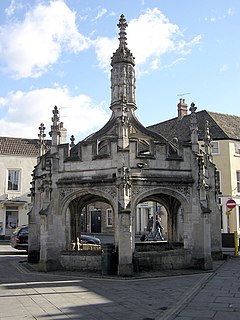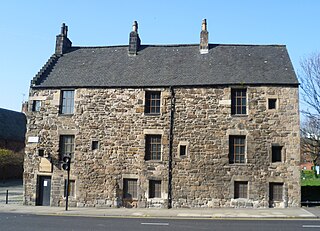
South Lanarkshire is one of 32 unitary authorities of Scotland. It borders the south-east of the City of Glasgow and contains some of Greater Glasgow's suburbs. It also contains many towns and villages. It also shares borders with Dumfries and Galloway, East Ayrshire, East Renfrewshire, North Lanarkshire, the Scottish Borders and West Lothian. It includes part of the historic county of Lanarkshire.

A market cross, or in Scots, a mercat cross, is a structure used to mark a market square in market towns, where historically the right to hold a regular market or fair was granted by the monarch, a bishop or a baron. Market crosses were originally from the distinctive tradition in Early Medieval Insular art of free-standing stone standing or high crosses, often elaborately carved, which goes back to the 7th century. Market crosses can be found in most market towns in Britain. British emigrants often installed such crosses in their new cities, and several can be found in Canada and Australia.

Dumbarton is a town in West Dunbartonshire, Scotland, on the north bank of the River Clyde where the River Leven flows into the Clyde estuary. In 2006, it had an estimated population of 19,990.

Pollok is a large housing estate on the south-western side of the city of Glasgow, Scotland. The estate was built to house families from the overcrowded inner city. Housing 30,000, it was built from the 1920s to the 1950s.

Port Glasgow is the second largest town in the Inverclyde council area of Scotland. The population according to the 1991 census for Port Glasgow was 19,426 persons and in the 2001 census was 16,617 persons. The most recent census in 2011 states that the population has declined to 15,414. It is located immediately to the east of Greenock and was previously a burgh in the former county of Renfrew.

Glasgow Cathedral, also called the High Kirk of Glasgow or St Kentigern's or St Mungo's Cathedral, is the oldest cathedral on mainland Scotland and is the oldest building in Glasgow. Since the Reformation the cathedral continues in public ownership, within the responsibility of Historic Environment Scotland. The congregation is part of the established Church of Scotland's Presbytery of Glasgow and its services and associations are open to all.
The cathedral and its kirkyard are at the top of High Street, at Cathedral Street. Immediately neighbouring it are Glasgow Royal Infirmary, opened in 1794, and the elevated Glasgow Necropolis, opened in 1833.
Nearby are the Provand's Lordship, Glasgow`s oldest house and its herbal medical gardens, the Barony Hall, University of Strathclyde, Cathedral Square, Glasgow Evangelical Church, and St Mungo Museum.

The Archbishop of Glasgow is an archiepiscopal title that takes its name after the city of Glasgow in Scotland. The position and title was abolished by the Church of Scotland in 1689; and, in the Scottish Episcopal Church, it is now part of the Episcopal bishopric of Glasgow and Galloway. In the Roman Catholic Church, the title was restored by Pope Leo XIII in 1878.

The Archdiocese of Glasgow was one of the thirteen dioceses of the Scottish church. It was the second largest diocese in the Kingdom of Scotland, including Clydesdale, Teviotdale, parts of Tweeddale, Liddesdale, Annandale, Nithsdale, Cunninghame, Kyle, and Strathgryfe, as well as Lennox, Carrick and the part of Galloway known as Desnes.

The Provand's Lordship of Glasgow, Scotland, is a medieval historic house museum located at the top of Castle Street within sight of the Glasgow Cathedral and Glasgow Royal Infirmary, and next to the St Mungo Museum of Religious Life and Art.
The Bishop's Castle, also known as Glasgow Castle and as the Bishop's Palace, was a medieval castle in Glasgow, Scotland. It served as the residence of the bishops and archbishops of Glasgow Cathedral until the Reformation, when the last Catholic archbishop, James Beaton, fled to France in about 1560. The castle was completely destroyed in the late 18th century, to make way for the Glasgow Royal Infirmary.

The Bishop of Caithness was the ecclesiastical head of the Diocese of Caithness, one of Scotland's 13 medieval bishoprics. The first referenced bishop of Caithness was Aindréas, a Gael who appears in sources between 1146 and 1151 as bishop. Aindréas spent much if not all of his career outside his see.
Walter Trail was a late 14th century Bishop of St. Andrews. He appears as an official in the Bishopric of Glasgow in 1378, as a Magister Artium and a Licentiate in Canon and civil law. In 1380, he has a Doctorate in Canon and Civil Law, as well as a Papal chaplain and auditor. In this year, Pope Clement VII granted him the deanery of the Bishopric of Dunkeld. He became treasurer of the Bishopric of Glasgow in either 1381 or 1382. On 29 November 1385, the Pope provided him to the vacant Bishopric of St. Andrews, vacant because of the capture and death of the previous bishop-elect, Stephen de Pa.
The Bishop of Glasgow and Galloway is the ordinary of the Scottish Episcopal Diocese of Glasgow and Galloway.
Barnard Castle was a county constituency centred on the town of Barnard Castle in County Durham, which returned one Member of Parliament to the House of Commons of the Parliament of the United Kingdom. It was created for the 1885 general election and abolished for the 1950 general election.
Bedlay Castle is a former defensive castle, dating from the late 16th and 17th centuries. It is located between Chryston and Moodiesburn in North Lanarkshire, Scotland. The castle is just off the A80 road, around 8 miles to the north-east of Glasgow, at NS692700.

Partick Castle was located in Partick, now a Western suburb of Glasgow. It was built in 1611 for the Glasgow benefactor George Hutcheson and situated on the west bank of the River Kelvin.

The Battle of Glasgow was fought on 16 March 1544, between Matthew Stewart, 4th Earl of Lennox and the Scottish Regent James Hamilton, 2nd Earl of Arran, and their adherents, during the minority of Mary, Queen of Scots. There was a second battle at Glasgow Muir in May 1544 between Arran and the Earl of Glencairn.

Renfrew is a town 6 miles (10 km) west of Glasgow, and the historical county town of Renfrewshire. Called the "Cradle of the Royal Stewarts" for its early link with Scotland's former royal house, Renfrew gained royal burgh status in 1397.
Events from the year 1996 in Scotland













